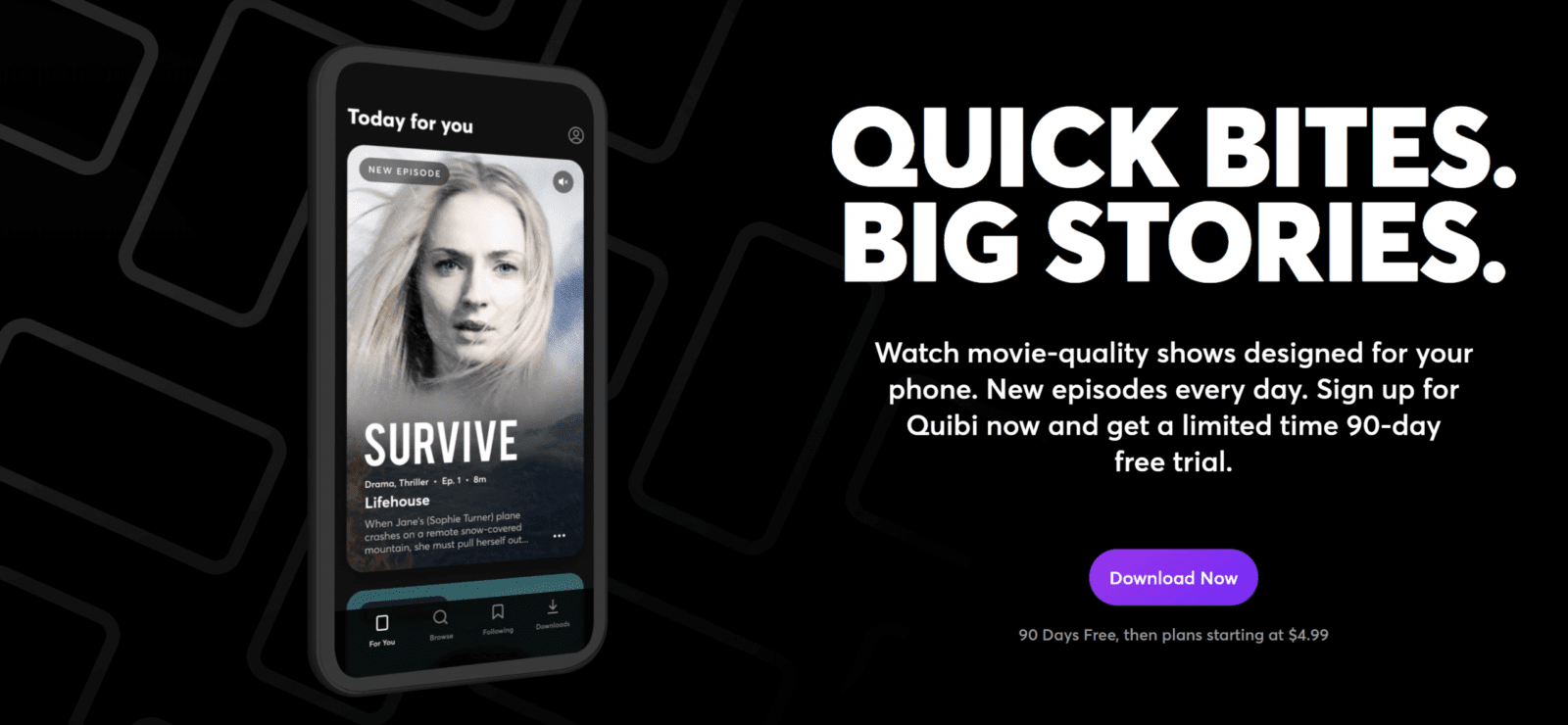By Kate McNee
—
First, there was Netflix. Then there was TikTok. Now comes a fusion: Quibi.
Short for “quick bites,” Quibi is the newest video-streaming platform to enter the competitive space. Launched on April 6, it offers 175 new high-production movies and TV shows in 10-minute “bites.” It’s an enticing concept. However, the question of adoptability remains. Will binge watchers like consuming engrossing dramas in minutes-long pieces? And moreover, will they pay for it?
Like many things, the answers to these questions, and Quibi’s true potential, are on hold given the current COVID-19 climate. But the unanimous takeaway from Quibi’s first week is the timing is tragically terrible. While Netflix customers binge to whittle away hours of time, watching clips designed for on-the-go seems…counterintuitive. Case in point: the Twittersphere’s biggest complaint is that mobile-only Quibi can’t be projected onto bigger screens. Womp, womp. Luckily, Quibi’s CEO says they will be enabling this in the future.
In response to everything going on, Quibi made the savvy business decision to offer consumers an extended complimentary three-month trial. This probably helped the platform achieve the 1.7 million downloads it reported in the first week. However, this means our final judgments on the platform must wait. Quibi’s true purpose, the need Quibi is meant to fill, won’t be possible until life returns to its fast-paced normal. Then and only then will we know if Quibi is valuable enough to pay for.
Quibi’s leadership portends success. In 2018, the platform’s company was founded by entertainment juggernaut Jeffrey Katzenberg, co-founder of DreamWorks Animation, who was looking for “the next big opportunity in entertainment.” In addition, Meg Whitman, former CEO of eBay and HP, serves as CEO. Branding Quibi as the “the third generation of film narrative,” the dynamic duo amassed close to $2 billion in investment capital before launch.
The platform has a truly differentiated product offering. Turnstyle, a technology that allows you to view content in different portrait and landscape perspectives when you flip the screen, is Quibi’s patent-pending feature. And I must admit, it’s cool. Imagine you’re watching your favorite drama. You’re captivated by a tight character shot but want a glimpse of the background. Turnstyle lets you do this, dynamically flipping between the two perspectives.
With mega-successful executives, high-profile investors, and an impressive array of Gen-Z heavy Hollywood talent – A-list celebrities include Liam Hemsworth, Chrissy Teigen, and Idris Elba – it’s no surprise that advertisers have caught on. The platform’s entire $150 million first-year ad budget sold out prior to launch, spurred undoubtedly by the fear of missing out on the “the next big thing” targeted to young people after TikTok.

Credit: Quibi
What’s pressing is the question of its place within the larger streaming mix. Quibi executives maintain the platform is more in competition with social networks than the ever-multiplying streaming platforms. Quibi’s quick mobile viewing does more closely mirror social media behavior than sit-down-don’t-leave-your-bed-for-hours Netflix consumption. However, this is exactly what confounds me. Miss a moment of a TikTok dance video because of a subway announcement? Not a big deal. Quibi’s high-production content, on the other hand, would require close viewing.
Take Survive, one of Quibi’s most publicized feature films. Starring Game of Thrones’ Sophie Turner and The Walking Dead’s Corey Hawkins, the movie follows their quest to survive after their plane crashes on an icy mountain. With nuanced facial expressions and hushed dialogue, the film requires one’s complete investment. Are people in the mindset to give this while they’re on the go?
Even if you see this as a non-starter, there’s the fact that Quibi will only release one episode (ten minutes or less) of its full-length movies per day. I’m simply not sure ten minutes gives enough time for consumers to get invested in a television show and be drawn to returning. That’s just not a lot of time to learn about the characters.
But it’s not all bad news: what I do see as working for the platform is the five clips of episodic and unscripted TV series Quibi premieres each day. Most of the content is light-hearted and funny: Dishmantled challenges chefs to make dishes while they wear blindfolds (yes, where they come up with this stuff is the mystery). And this is exactly why I see it as perfect for this medium. While people are on-the-go, they’re looking to be quickly entertained and informed, and Dishmantled fits this bill. However, content will need to be high-quality and uniquely suited to this platform. If not, users will return to YouTube for this type of content for free. And “competing against free,” as Katzenberg has stated Quibi will be, is a big obstacle.

Credit: Quibi
In the digital age, it’s impossible to predict the future. Minute-long movie clips could end up peaking user interest, and revolutionize movie viewing for the Millennial/Gen-Z audience. But following the mega-hyped flops of Fyre Festival and Cats, I think it’s important to practice thoughtful skepticism about pre-released, influencer-backed offerings. A resume doesn’t spell success. Only adoption does.
—
 Kate McNee is a Paid Social Media Strategist at Acronym, working across clients in education, hospitality, and construction. With more than three years of experience in social media strategy and execution from both the client and agency side, Kate leverages her background in social media content development, strategic planning, and platform execution to drive client business goals.
Kate McNee is a Paid Social Media Strategist at Acronym, working across clients in education, hospitality, and construction. With more than three years of experience in social media strategy and execution from both the client and agency side, Kate leverages her background in social media content development, strategic planning, and platform execution to drive client business goals.










